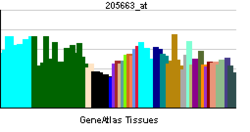- PCBP3
-
Poly(rC) binding protein 3 Identifiers Symbols PCBP3; ALPHA-CP3 External IDs OMIM: 608502 MGI: 1890470 HomoloGene: 23233 GeneCards: PCBP3 Gene Gene Ontology Molecular function • DNA binding
• RNA bindingCellular component • nucleus
• nucleolus
• cytoplasm
• mitochondrion
• cytosol
• ribonucleoprotein complex
• intracellular membrane-bounded organelleBiological process • mRNA metabolic process Sources: Amigo / QuickGO RNA expression pattern 
More reference expression data Orthologs Species Human Mouse Entrez 54039 59093 Ensembl ENSG00000183570 ENSMUSG00000001120 UniProt P57721 P57722 RefSeq (mRNA) NM_001130141.1 NM_021568.2 RefSeq (protein) NP_001123613.1 NP_067543.2 Location (UCSC) Chr 21:
47.06 – 47.36 MbChr 10:
76.22 – 76.42 MbPubMed search [1] [2] Poly(rC)-binding protein 3 is a protein that in humans is encoded by the PCBP3 gene.[1][2]
This gene encodes a member of the KH-domain protein subfamily. Proteins of this subfamily, also referred to as alpha-CPs, bind to RNA with a specificity for C-rich pyrimidine regions. Alpha-CPs play important roles in post-transcriptional activities and have different cellular distributions. This gene's protein is found in the cytoplasm, yet it lacks the nuclear localization signals found in other subfamily members. Multiple polyadenylation sites exist for this gene.[2]
References
- ^ Makeyev AV, Liebhaber SA (Sep 2000). "Identification of two novel mammalian genes establishes a subfamily of KH-domain RNA-binding proteins". Genomics 67 (3): 301–16. doi:10.1006/geno.2000.6244. PMID 10936052.
- ^ a b "Entrez Gene: PCBP3 poly(rC) binding protein 3". http://www.ncbi.nlm.nih.gov/sites/entrez?Db=gene&Cmd=ShowDetailView&TermToSearch=54039.
Further reading
- Makeyev AV, Liebhaber SA (2002). "The poly(C)-binding proteins: a multiplicity of functions and a search for mechanisms.". RNA 8 (3): 265–78. doi:10.1017/S1355838202024627. PMC 1370249. PMID 12003487. http://www.pubmedcentral.nih.gov/articlerender.fcgi?tool=pmcentrez&artid=1370249.
- Kiledjian M, Wang X, Liebhaber SA (1995). "Identification of two KH domain proteins in the alpha-globin mRNP stability complex.". EMBO J. 14 (17): 4357–64. PMC 394520. PMID 7556077. http://www.pubmedcentral.nih.gov/articlerender.fcgi?tool=pmcentrez&artid=394520.
- Hattori M, Fujiyama A, Taylor TD, et al. (2000). "The DNA sequence of human chromosome 21.". Nature 405 (6784): 311–9. doi:10.1038/35012518. PMID 10830953.
- Makeyev AV, Eastmond DL, Liebhaber SA (2002). "Targeting a KH-domain protein with RNA decoys.". RNA 8 (9): 1160–73. doi:10.1017/S135583820202808X. PMC 1370330. PMID 12358435. http://www.pubmedcentral.nih.gov/articlerender.fcgi?tool=pmcentrez&artid=1370330.
- Strausberg RL, Feingold EA, Grouse LH, et al. (2003). "Generation and initial analysis of more than 15,000 full-length human and mouse cDNA sequences.". Proc. Natl. Acad. Sci. U.S.A. 99 (26): 16899–903. doi:10.1073/pnas.242603899. PMC 139241. PMID 12477932. http://www.pubmedcentral.nih.gov/articlerender.fcgi?tool=pmcentrez&artid=139241.
- Chkheidze AN, Liebhaber SA (2003). "A novel set of nuclear localization signals determine distributions of the alphaCP RNA-binding proteins.". Mol. Cell. Biol. 23 (23): 8405–15. doi:10.1128/MCB.23.23.8405-8415.2003. PMC 262676. PMID 14612387. http://www.pubmedcentral.nih.gov/articlerender.fcgi?tool=pmcentrez&artid=262676.
- Ota T, Suzuki Y, Nishikawa T, et al. (2004). "Complete sequencing and characterization of 21,243 full-length human cDNAs.". Nat. Genet. 36 (1): 40–5. doi:10.1038/ng1285. PMID 14702039.
- Gerhard DS, Wagner L, Feingold EA, et al. (2004). "The status, quality, and expansion of the NIH full-length cDNA project: the Mammalian Gene Collection (MGC).". Genome Res. 14 (10B): 2121–7. doi:10.1101/gr.2596504. PMC 528928. PMID 15489334. http://www.pubmedcentral.nih.gov/articlerender.fcgi?tool=pmcentrez&artid=528928.
- Lim J, Hao T, Shaw C, et al. (2006). "A protein-protein interaction network for human inherited ataxias and disorders of Purkinje cell degeneration.". Cell 125 (4): 801–14. doi:10.1016/j.cell.2006.03.032. PMID 16713569.
- Hu YH, Warnatz HJ, Vanhecke D, et al. (2006). "Cell array-based intracellular localization screening reveals novel functional features of human chromosome 21 proteins.". BMC Genomics 7: 155. doi:10.1186/1471-2164-7-155. PMC 1526728. PMID 16780588. http://www.pubmedcentral.nih.gov/articlerender.fcgi?tool=pmcentrez&artid=1526728.
Categories:- Human proteins
- Chromosome 21 gene stubs
Wikimedia Foundation. 2010.
